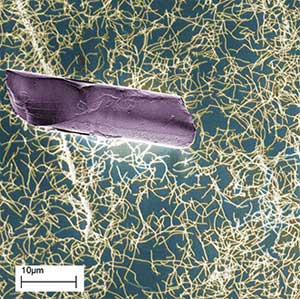Definition – What is nanotechnology?
A word of caution
Truly revolutionary nanotechnology products, materials and applications, such as nanorobotics,
are years in the future (some say only a few years; some say many
years). What qualifies as "nanotechnology" today is basic research and
development that is happening in laboratories all over the world.
"Nanotechnology" products that are on the market today are mostly
gradually improved products (using evolutionary nanotechnology)
where some form of nanotechnology enabled material (such as carbon
nanotubes, nanocomposite structures or nanoparticles of a particular
substance) or nanotechnology process (e.g. nanopatterning or quantum
dots for medical imaging) is used in the manufacturing process. In their
ongoing quest to improve existing products by creating smaller
components and better performance materials, all at a lower cost, the
number of companies that will manufacture "nanoproducts"
(by this definition) will grow very fast and soon make up the majority
of all companies across many industries. Evolutionary nanotechnology
should therefore be viewed as a process that gradually will affect most
companies and industries.
Definition of nan'o•tech•nol'o•gy n
So what exactly is nanotechnology? One
of the problems facing nanotechnology is the confusion about its
definition. Most definitions revolve around the study and control of
phenomena and materials at length scales below 100 nm and quite often
they make a comparison with a human hair, which is about 80,000 nm wide.
Some definitions include a reference to molecular systems and devices
and nanotechnology 'purists' argue that any definition of nanotechnology
needs to include a reference to "functional systems". The inaugural
issue of Nature Nanotechnology asked 13 researchers from different areas what nanotechnology means to them and the responses, from enthusiastic to sceptical, reflect a variety of perspectives.

Human hair fragment and a network of single-walled carbon nanotubes (Image: Jirka Cech)
It seems that a size limitation of
nanotechnology to the 1-100 nm range, the area where size-dependant
quantum effects come to bear, would exclude numerous materials and
devices, especially in the pharamaceutical area, and some experts
caution against a rigid definition based on a sub-100 nm size.
Another important criteria for the definition is
the requirement that the nano-structure is man-made. Otherwise you
would have to include every naturally formed biomolecule and material
particle, in effect redefining much of chemistry and molecular biology
as 'nanotechnology.'
The most important requirement for the
nanotechnology definition is that the nano-structure has special
properties that are exclusively due to its nanoscale proportions.
The U.S. National Nantechnology Initiatve (NNI) provides the following definition:
Nanotechnology
is the understanding and control of matter at dimensions between
approximately 1 and 100 nanometers, where unique phenomena enable novel
applications. Encompassing nanoscale science, engineering, and
technology, nanotechnology involves imaging, measuring, modeling, and
manipulating matter at this length scale.
A
nanometer is one-billionth of a meter. A sheet of paper is about
100,000 nanometers thick; a single gold atom is about a third of a
nanometer in diameter. Dimensions between approximately 1 and 100
nanometers are known as the nanoscale. Unusual physical, chemical, and
biological properties can emerge in materials at the nanoscale. These
properties may differ in important ways from the properties of bulk
materials and single atoms or molecules.
We found another good definition that is practical and unconstrained by any arbitrary size limitations (source):
The
design, characterization, production, and application of structures,
devices, and systems by controlled manipulation of size and shape at the
nanometer scale (atomic, molecular, and macromolecular scale) that
produces structures, devices, and systems with at least one
novel/superior characteristic or property.

No comments:
Post a Comment